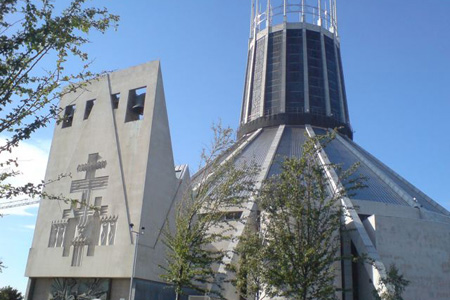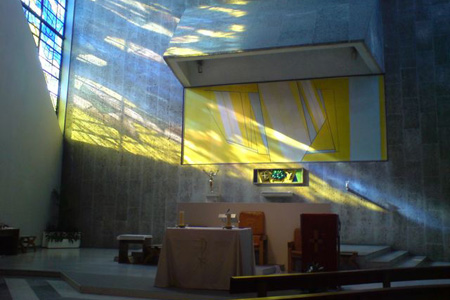 |
||||||||||
 |
||||||||||
|
1458: Metropolitan Cathedral of Christ the King, Liverpool,
England Mystery Worshipper: Strange Pilgrim. The church: Metropolitan Cathedral of Christ the King, Liverpool, England. Denomination: Roman Catholic. The building: Nicknamed "Paddy's Wigwam" for its shape and Irish connections, the cathedral has been a prominent Liverpool landmark since 1966. Designed by Sir Frederick Gibberd, who also designed Harlow New Town and the terminal buildings at Heathrow Airport, the cathedral replaces three earlier efforts that were never finished. The second of those, designed by Sir Edwin Lutyens, whose other works include the central administrative area of New Delhi, India, and that curiosity piece known as Queen Mary's Dolls' House, would have rivalled St Peter's Basilica in size and splendour if finished. The present cathedral sits atop the crypt of Lutyens' building. A triumphal flight of steps flanked by banners leads up to the main entrance, which Pevsner described as almost Aztec; this opens into the circular nave which is lit by a lantern in the shape of the crown of thorns, incorporating vibrantly coloured stained glass. The high altar, of white marble, is immediately beneath this; around the perimeter, and projecting outwards, are various chapels, including that of the blessed sacrament, where the mass was held that is the subject of this report. The church: As the seat of the Archbishop of Liverpool, this is the mother church for the Northern Province of the Catholic Church in England, comprising seven dioceses in all. Liverpool has a large Catholic population, and the cathedral congregation reflects this diversity quite well, with perhaps a middle-class and student bias owing to its location. There is a significant proportion of people from overseas, both immigrants and visitors. The neighbourhood: The cathedral stands at one end of the aptly named Hope Street, facing its sister Anglican cathedral. The campus of the University of Liverpool adjoins the cathedral, and several other institutions of higher and further education are in the vicinity. Hope Street and its neighbours are full of restaurants, clubs and pubs, the Philharmonic Hall and two theatres. However, some of the poorest inner-city housing estates were on the doorstep until very recently (mostly now turned over to student housing). The cast: His Eminence Javier Cardinal Lozano Barragán, president of the Pontifical Council for Pastoral Assistance to Health Care Workers, was the principal celebrant. Concelebrating with His Eminence were the Rt Revd Thomas Anthony Williams, Auxiliary Bishop of Liverpool; the Rt Revd Vincent Malone, Auxiliary Bishop Emeritus of Liverpool; and the Revd Canon Anthony O'Brien, dean of the cathedral. The date & time: Friday, 29 June 2007, 5.15pm. What was the name of the service? Sung Mass for the Solemnity of Saints Peter and Paul. How full was the building? The mass was held in the Blessed Sacrament Chapel, which was comfortably full – I would estimate about 80 people plus the choir, who sat in their stalls immediately behind us. Did anyone welcome you personally? No, but there were stewards handing out leaflets who seemed polite and businesslike. I sneaked up and helped myself to a copy while one of them was occupied helping someone else. During the peace ceremony there were warm smiles and genuine handshakes from those around me. Was your pew comfortable? Yes – simple but solid wooden bench with exactly the right space to use the kneeler in front. How would you describe the pre-service atmosphere? Quiet and prayerful. Three-quarters of the congregation were in place five minutes before the start, and the few latecomers caused no disturbance. The only distraction (a minor and necessary one) was a server making last-minute preparations in the sanctuary. What were the exact opening words of the service? "In the name of the Father, and of the Son, and of the Holy Spirit." We then sang a hymn for which no announcement was made. What books did the congregation use during the service? An A5 leaflet including the words of the hymn (there was only one), and music for the psalm, alleluia verse, sanctus etc. There was also an A4 sheet with the text of the readings from the Jerusalem Bible. What musical instruments were played? Organ – very gently and sensitively. The cathedral is blessed with three pipe organs: one in the nave, one in the Blessed Sacrament Chapel, and one in the crypt. The responsorial psalm was accompanied from a different console; I don't know whether this linked to the chapel organ or if it was a standalone electronic instrument. Did anything distract you? The over-short alb of one of the concelebrants, revealing six inches of trouser leg. Was the worship stiff-upper-lip, happy clappy, or what? Formal in the sense of not chatty, but a relaxed ceremonial done with dignity and without fuss. All of the concelebrants wore matching scarlet chasubles, but no mitres. They were assisted by two servers. There was no incense. The choir, as ever at the Metropolitan Cathedral, sang beautifully – parts of a setting by Tomás Lúis de Victoria, and leading the congregation in Gregorian chant for the sanctus etc. They looked very Anglican – long surplices, academic hood for the choirmaster and ruffs for the boys.  Exactly how long was the sermon? 9 minutes. On a scale of 1-10, how good was the preacher? 6 – Cardinal Barragán, who is Mexican, explained that he was visiting the UK to attend a conference on hospital chaplaincy and apologised for his broken English. He was rather difficult to hear at first, perhaps because he was nervously avoiding the microphone, but he relaxed into it and became easier to follow. But his accent was so strong that I lost the thread of some sentences altogether. In a nutshell, what was the sermon about? He spoke of the gift of unity, and compared it to the trinity. Uniformity would be the denial of unity because it contradicts this model. He spoke of the need for reconciliation and forgiveness and how St Peter epitomised this, and hence his successor the Pope. Which part of the service was like being in heaven? The music, especially the Gregorian chant in which the congregation was invited to join. I remember singing the same sanctus many years ago, although to English (BCP) words rather than Latin. The sunlight filtering through the stained glass onto the joyful abstract painting which serves as the reredos (see picture). The Mexican celebrant and the presence of other ethnicities and nationalities in the congregation wonderfully embodied the universality of the Catholic Church. And which part was like being in... er... the other place? The contrast between the words, in sermon and prayers, about the unity of the Church and the reality that I, as a baptised Anglican Christian, was denied communion. (I am not criticising the official teaching, just pointing out its consequences.) Despite the provision of two service sheets, neither of them included the words for the confession or Nicene creed. If I were a totally clueless stranger I would have been completely lost. What happened when you hung around after the service looking lost? There were gowned stewards rushing about busily tidying up, and other members of the congregation drifting off in ones and twos, but no one so much as offered eye contact. Most cathedrals, especially Catholic ones, are not as "clubby" as the average Anglican parish church, so I was neither surprised nor upset by this. We tried to leave, but the main door was locked! Finally I fell into company with a gentleman who appeared to be Polish, judging from his accent and an uncanny resemblance to the late Pope John Paul II, and together we managed to find an unlocked door. How would you describe the after-service coffee? There was none, and the cathedral's coffee shop had closed for the day. However, it is unfair to expect refreshments on a weekday evening, and I understand that the congregation are invited to coffee on Sunday mornings. How would you feel about making this church your regular (where 10 = ecstatic, 0 = terminal)? 9 – This cathedral epitomises the best of modern Roman Catholic liturgy and spirituality, and as a catholic Anglican I feel very much at home here. But I could not worship regularly without receiving the blessed sacrament, so visits must remain an occasional treat. Did the service make you feel glad to be a Christian? Very much so. I felt the unity in diversity of the Church very strongly, despite the sadness of being excluded at the moment of communion. What one thing will you remember about all this in seven days' time? The serenity of the chapel, with the sunlight on the reredos. And the elderly cardinal's valiant attempt to preach and say the mass in a foreign language. |
|
|
||||||||||||||||||||||||||||||||||||
| More Mystery Worshipper reports | |||||||||||||||||||||||||||||||||||||||
 |
|||||||||||||||||||||||||||||||||||||||






